Culling the Flock and Butchering Old Hens
Monday morning I butchered some of my old hens. The oldest hen in my flock was one of the unlucky ones. She was an Ameraucana from my very first flock of 10 purchased the summer we moved here (2010). She was about 3 years old. I don’t keep old hens around for very long. I have more to put in freezer camp as I have time to butcher. I am down to 55 hens and pullets right now and I hope to have it closer to 40 over the next couple of weeks.
If you are interested in complete instructions for processing, check out my post How to Butcher Chickens on the Cheap. Today I just want to share the post-butchering process of freezing and cooking the stewing hens.
Dressed for the Stew Pot
After I finished butchering 6 old hens, I brought them into the house and washed them thoroughly. I try to remove as many feathers as I can when I pluck, but it is difficult to get the pin feathers and the dark-colored feather shafts embedded in the skin. As you can see from some of the photos, the dark hens have dark feather shafts. Let’s just say that Black Australorps and Rhode Island Reds don’t dress up pretty. White or light-colored birds are better for butchering and keeping the skin on for roasting or frying.
I froze four of the hens to stew later on. I really didn’t know if I would have enough time to stew and pick the carcasses of all 6 hens right away, and I didn’t want to waste them. Normally I would use the vacuum sealer to keep the birds from getting freezer burned, but the bags are a bit pricey and I am planning to take care of them as soon as I can. So they went into freezer bags for quick and easy storage.
Off to freezer camp they went, where they joined the broilers I butchered in November, the turkeys I butchered in October (see my post How to Butcher a Turkey), and some locally raised pork. We also have another freezer full of locally raised beef. We should have plenty of meat for meals this year!
The last two hens went into the pot with enough water to (mostly) cover them, plus some bay leaves and sliced onion. I left them on the burner to slowly stew for the whole afternoon and into the evening. The pot was left to cool for a bit then Tom put it in the fridge to chill overnight.
In the morning I pulled the pot out and removed the meat from the bones, poured the broth through a sieve (to remove any feathers or bones), then put the meat, broth, carrots, and some fresh cilantro in a pot to cook on the wood stove for the afternoon. When the carrots were nearly tender, I added some frozen corn, crushed garlic, more herbs and spices, and some organic orzo pasta to the pot. The scent was heavenly.
I’ve considered giving my old hens away on Craigslist or Freecycle. It can be a pain to find the time to butcher them and, quite frankly, I find it harder (emotionally) to butcher them than the broilers I raise specifically for this purpose. Plus they are a bit tough unless you cook them for a long time.
But I’ve raised most of them from chicks, fed them, cared for them, and made sure that they had a natural, humane life. If I give them away, I won’t know how they are treated or how their lives end. I want to be sure that they don’t suffer and in the process, I use them to make a nutritious pot of soup for my family. So it’s worth the extra effort and inconvenience.
It’s a good feeling to have a big pot of soup on the stove, while I go about my afternoon. The aroma fills the house and dinner time can’t arrive too soon. I also have the bones and scraps to feed back to the chickens still scratching around in their coop. They have no idea that these bones were once their flock mates. It might seem a bit macabre, but this is the circle of life on a homestead.
Do you butcher your old hens? Leave a comment!

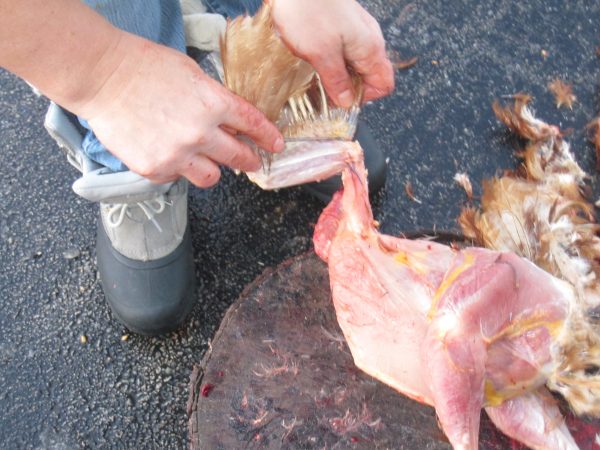
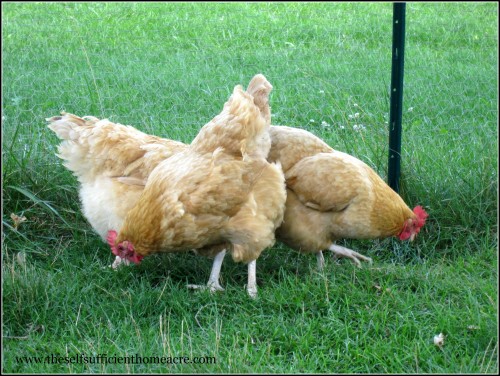


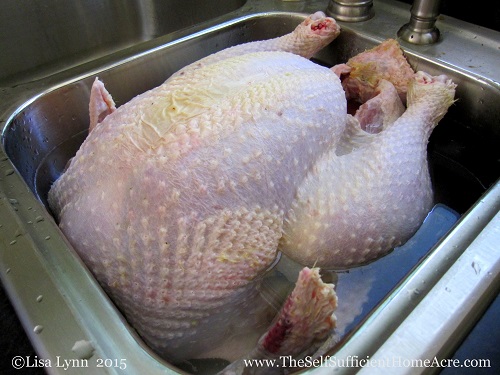
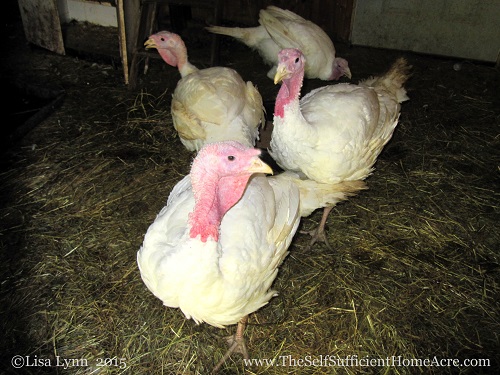
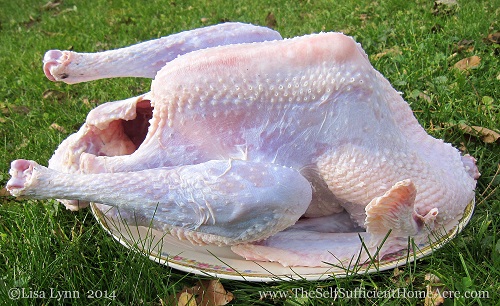

Hi! I’m not sure if you’ve looked into this but old hens are a high demand item among chinese people. I’m currently pregnant and I’ve been looking EVERYWHERE for free range old hens. I can’t find any! Old hens are specifically used to make broth for postpartum care to restore strength. My mom said that for my first month of postpartum, I need at least FIVE of them and I need to drink the broth in large quantities daily to support the production of breast milk and also to restore my personal health. Problem is I can’t find even one. As far as I know, the hens need to be at least 6 years old and that just doesn’t happen in the US as far as I know! I’d happily settle for 5! What we’ve been told is that the scales on the feet of the hen need to be so thick that they look like they’re wearing leg warmers. The ones I’ve seen, like the 3 year olds, still look like young chickens to me and they haven’t developed the hormones that make them nourishing in a chinese herbal soup.
Hi Annie,
I’m sorry that you are having trouble finding hens old enough for the broth you want to make. This is very interesting… I love reading about natural methods of improving our health and this is quite intriguing! I have 2 or 3 hens that are about 5 years old now but I don’t know if you’re anywhere near me. I live outside of Chicago.
No i don’t think your a big meanie, i have my first chickens and intend on doing the same thing. I have raised rabbits and several hogs and although my place is small i enjoy my chickens and agree with you very much about life and i am just living mine to the fullest and giving my family the best that i have offer by caring for my chickens i know what is in the food i give to them and my family.
Thanks for sharing! I understand completely why you would choose this life!
A great read, thanks. We’ve had our hens some for just over 3 years. We have one that’s about 5 years old. The others don’t let her eat much. I’ve watched that. We just don’t have the heart to butcher these guys. I was thinking of calling the local butcher to find if they will come out and do that for us. I wish I could, but cutting the heads off when they’re alive just doesn’t do it for me. Darn it. I know we’re holding on too long too for a couple hens. Just putting food out knowing these gals are too old.
Hi Kathy,
I understand completely. You can certainly check with the butcher, but don’t be surprised if they are not legally allowed to do this in your area. It is worth checking into, but many areas have pretty strict rules about home butchering and poultry processing may require a different license than pork and beef.
Best wishes…I have some old ones that I think are going to go to another farm as pets. If they are willing to feed them for the fun of having them, I will be happy to send them along. Usually I dont’ do that, but we have so much meat in the freezer and canned on the shelves that I really don’t need to butcher. And I find that my heart just isn’t into it this fall. 🙂 Maybe that sounds wishy washy…oh well.
Hi Lisa Lynn,
I’m with you about the expense of vacuum seal freezer bags. I too regularly use zip freezer bags especially with the zucchini slices I get from the garden – you know how prolific summer squash gets! Air around frozen veggies and meat is a killer so removing as much air as possible preserves the frozen food.
What I do to mimic vacuum sealing in the regular zip freezer bags is to zip the top seal and leave about an inch unzipped. I insert a thin coffee straw from a fast food restaurant into the bag. I finish zipping the bag up to the protruding straw. I exhale deeply, put my mouth over the straw, and then inhale a deep breath of air without stopping until the freezer bag completely vacuum seals itself around the zucchini and quickly finish zipping shut the bag. It takes a couple of tries to get the rhythm of it.
I save a ton of money using these zip freezer bags and then reuse them for kitchen scraps for the compost pile after dinner! They zip shut nicely to hold in any odors. The zip freezer bags are so sturdy I wash and reuse them 2 or 3 x before they lose their stiff shape. I don’t re-use them after meat is in them as the greasiness is hard to remove. But, I use them for bread, vegetables, grains, frozen veggies and afterwards wash, dry and re-use them another day.
Hi Sylvester,
I reuse my freezer bags too, until they are too beat up for food. Then I use them to pick up doggie doo on our walks! I really hate to throw plastic in the garbage, so I use it as many times as I can before discarding.
I also squeeze as much air out as I can…although I wasn’t able to get the rhythm of using the straw. Maybe I should pick up some straws and try it again. I might be a bit more patient and maybe, just maybe, a bit wiser now than the last time I tried this! (I did say maybe, right?!)
Thanks for the suggestions!
I think its good to know. We have forgotten the process of feeding our family the way the older generation use too. Before supermarkets supplied our foods.
So true, Connie! Many people don’t realize this, but the canned chicken soup from the store is made with the old laying hens when they aren’t productive enough…so what I do is just the same. 🙂 Except much more humane!
Our hens have really started declining in their egg production. They are around 2.5 years old now, and the temperatures are dropping. We will probably get new chicks this spring. Not bothered by the butchering process. We also raise meat chickens every year and have a homemade whizbang plucker, a portable (homemade) sink and counter area, and we use a turkey fryer as a scalder. We can usually go through 30 chickens in about 2 hours. That’s from the pen, killed, cleaned,and in a cooler of ice water. Packing for the freezer takes a bit longer. I’d say we’ll use the same process with the egg layers. If you butcher many birds, the scalding method and plucker machine make all the difference. When scalded correctly, they are plucked clean as a whistle in under 20 seconds. Love that machine.
Hi Teresa,
I think it’s great that you cull the hens yourselves! I have never used a whizbang plucker…but I have found that the scalding makes the plucking pretty easy. Although if I were doing a lot of birds…it would a great thing to have on hand!
Thanks for sharing this with us!
We’ll be culling some older hens for the first time this spring. The oldest are only 2 years old, but a handful of them just aren’t as great as the others. Either they aren’t laying as well, or they regularly get out (ie, any hen with a clipped wing is toast… Only habitual offenders get wings clipped). We regularly butcher their male offspring, and have culled two hens we caught with egg on their beaks.
A few of our 30 or so hens are favorites/pets and will live out their lives whether they stop laying or not. The rest are free game if they prove to be a problem. I’ve found that it’s much easier to reconcile butchering a bird that is a problem (mean, not laying, always out, etc).
Hi Rae,
I totally understand your reasons for culling 🙂 Most of mine are around the same age. I used to have a few that were more friendly and I named them, didn’t want to cull them. But a possum took care of that for me 🙁 I’ve decided not to name them anymore and I am no longer attached to any of them. But I understand completely! Good luck with your culling process!
I admire your committment to now only raise them, but butcher them humanely. My parents have had chickens for several years now, but have an agreement with a local Amish family. They either trade older hens for chicks, or butcher them all for her and they split the meat. It’s a win-win for both families.
Hi Rene,
That’s great that your parents have been able to work together for a beneficial arrangement with a local family like that! My parents live close to an Amish community and I remember that it was no biggie to see buggies on the road as a kid. Pretty cool 🙂 Thanks for commenting and have a great day!
Lisa Lynn I loved this post and should be inspiring for all those battling with the thought of having to butcher their livestock. thank you for sharing this with us at Seasonal Celebration! Rebecca @ Natural Mothers Network x
We are doing a lot around our place! we just moved from our urban homestead on about 1/4 acre to 10.5 acres that need a LOT of work to be truly functional. We got some hens and ducks last week, but are preparing a spot for goats as well. We anticipate adding more meat chickens here as before we only had layers. I actually look forward to your other post a bit–though apprehensively as we are a little nervous about the processing end of food production, but also think it’s an essential part of the human experience. Anyway, thanks for sharing!
Hi Lacey,
Congratulations on your new place! 10.5 acres sounds wonderful…and I can only imagine how busy you must be. 🙂 Best wishes with all the new animals, I know you will do fine! Where there’s a will, there’s a way. The butchering post is up for you to check out when you’re ready. 🙂
I hope to hear more about your adventures!
Lovely to find your blog. We are taking the next step of raising our birds for the pot – geese at the moment. So interested to read this post. I’m so anti buying my food at the supermarket with not knowing what the animal/vegetable has been fed or how the animal was cared for. I’ve made our family aware the goslings will be going in the pot. We look at them differently and even tolerate them eating my garden and pooping everywhere (big learning curb re fences).
Chickens – ours should go in the pot but have been pets – so next generation might get treated differently.
Lovely to meet you,
Love Leanne
Welcome Leanne! I haven’t raised geese yet. I may have to wait until we have more room. I would love to hear more about your experience!
Best wishes with your adventures! Thanks for commenting 🙂
This is a great post about both the process of butchering and the philosophy to go along with it. Butchering day is not my favorite time, but I too feel good knowing we have given the chickens a good life and now they are giving back to us. The butchering gets easier every time. Our laying hens and roos tend to get non-food names but our pigs have been called Bacon, Ham, Porky, etc. and the beef cattle get names like Pot Roast and T-Bone.
Thank you so much Maria! I love the names you give your animals that are intended for food! And I agree completely that it is a good feeling to know that your livestock has had a good life. It gets easier for me too. But I hope that it never becomes too easy…I don’t want to have a hardened heart.
I would love for you to come over to my blog hop and share this there!
https://countrifiedhicks.blogspot.com/2013/02/mondays-with-countrified-hicks-blog-hop.html
I have nothing but admiration for someone who gives an animal a good life AND has the gumption to do the deed herself. I think that’s a very honest way to live. And that’s some yummy looking chicken meat!
Thank you so much Joan 🙂
We are planning on getting some laying hens in the next month just as soon as Jon can get the coop built. Initially we will only have a handful unlike the large flock you have. However, we do hope to expand and will plan on butchering when necessary. No, I do not think you are a meanie. However, I do not know if I can do it. I have told Jon he may have to handle all the butchering and let me take over once they look like a store bought chicken…lol. I don’t know if I will be able to watch your tutorial, but I am sure he will find it useful.
~Ann
Hi Ann,
I understand how you feel. I helped butcher when I was a kid, but never actually swung the ax myself. So I was unsure if I could do the dirty work. But I started with rabbits, and the very first one I killed was out of mercy. She was dying of pneumonia. After butchering my own rabbits, chickens were not a huge deal. But I do feel bad ending the life of a hen that has provided eggs and entertainment.
Best wishes with your chickens! I can’t wait to hear about your new flock when you get started!
We are planning for our first cull in about 6 weeks when our Dorking hens reach maturity (about 26 weeks I think) and I too am looking forward to your tutorial. Well, not looking forward but more eagerly anticipating the assistance and guidance. 🙂 We too sort of name our pot-planned birds; Butter, Fried, Casserole, Cacciatore, etc. It gives us a giggle and the kids find it funny too.
Hi Jessie,
Best wishes with your chicken butchering! I was wondering though, if your hens are reaching maturity at 26 weeks, don’t you want them for laying eggs? Or maybe you have roosters too? Just curious!
Love the funny chicken names 🙂
I don’t think I’ll have the emotional fortitude to butcher my hens, but I agree with Meredith about it being a good death and with you about not passing on the responsibility to someone else. I admire that you’re able to do it. It’s a quick death, without anticipation, sickness or prolonged pain.
Bonnie
http://www.HungryChickenHomestead.com
I remember reading about the conditions endured by old laying hens from a factory farm on their way to processing…many died on the trip. All to make canned chicken soup. I won’t touch the stuff anymore.
Thanks for stopping by Bonnie. I think you would be surprised at what you can do once you decide you are going to do it! But I also agree that it is a tough thing to do.
Thank you for sharing this, I’m looking forward to the tutorial. I agree with you about dispatching your own old birds, it’s sort of like a promise I make when the chicks are little–I’ll give you a good life–and death. We always name any little roosters, Stew.
What a great way to look at it Meredith. And I love the name for your roosters…Stew! 😉
I’d like to get a few more photos before I do the tutorial. Some of the ones I have came out a bit dark or blurry. So let’s see, I need to place an order for a warm sunny day so that I can butcher birds and take photos…no problem!